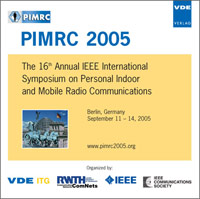Optimal Resource Allocation for UWB Wireless Ad Hoc Networks
Conference: PIMRC 2005 - 16th Annual IEEE International Symposium on Personal Indoor and Mobile Radio Communications
09/11/2005 - 09/14/2005 at Berlin, Germany
Proceedings: PIMRC 2005
Pages: 5Language: englishTyp: PDF
Personal VDE Members are entitled to a 10% discount on this title
Authors:
Zou, Chuanyun; Zygmunt Haas, (School of Electrical and Computer Engineering, Cornell University, Ithaca, NY 14853, USA)
Abstract:
In this paper, we study the problem of maximizing the throughput of UWB-based wireless ad-hoc networks by optimal allocation of radio resources, such as transmission rates and transmission powers. In particular, we determine the transmission rate of a link (which is transmission-power dependent) that maximizes the link's throughput. We show that if a link's transmission rate is adapted to this optimal transmission rate then, as the number of concurrently operating links increases, the maximal total network throughput approaches a constant and each link’s throughput approaches zero. We conclude that for sufficiently large transmission power, the throughput of the single-link case exceeds the total network throughput of the multiple-links case. We then present an optimal transmission scheduling scheme that maximizes the network throughput. Based on this scheme, and for the case of small maximal attainable power and weak interference levels, the scheduling scheme allocates simultaneous transmissions of multiple links. However, for the case of large maximally attainable power and strong interference levels, the scheduling scheme assigns separate times for transmission on each link. The breakpoint of when it is preferable to use a separate time for any link, as opposed to simultaneous transmission over multiple links, is determined by the value of the maximal transmission power of the links. Finally, we argue that, in contrast with previous studies, the design of the optimal Medium MAC protocol is dependent on the choice of a routing scheme.


